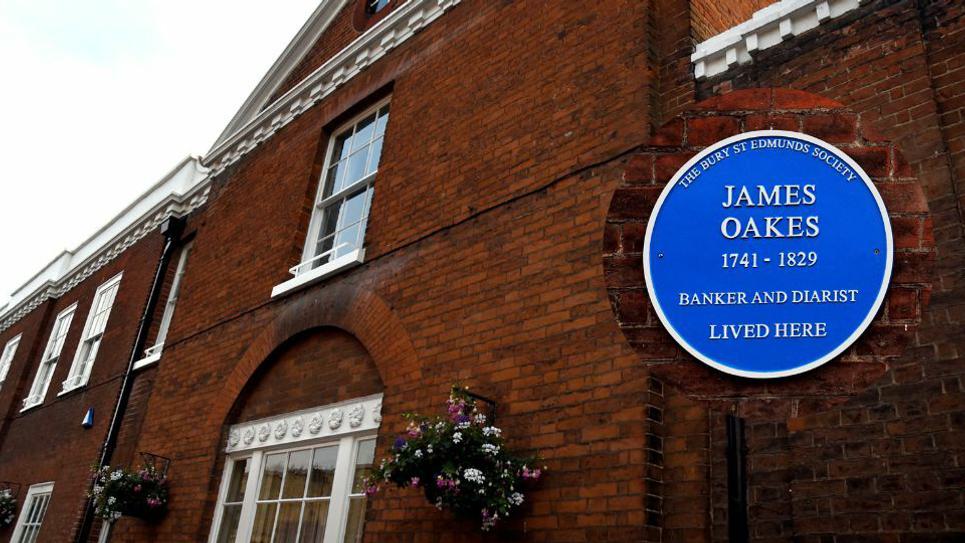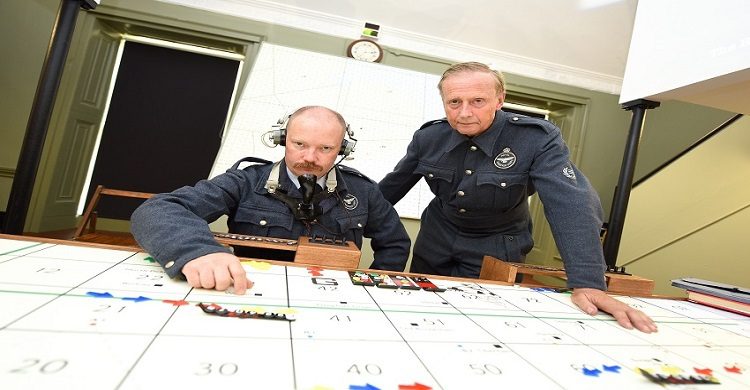
Back to Blogs
Discover
Bury St Edmunds' Blue Plaques Trail
Bury St Edmunds' blue plaques link the people of the past with the buildings of the present and following the blue plaque trail is a wonderful way to see Bury St Edmunds town centre while walking through history.
Charles Dickens (1812-1870) - The Angel Hotel, Angel Hill

The famous Victorian novelist stayed at The Angel Hotel as did his eponymous hero Samuel Pickwick in The Pickwick Papers. This blue plaque was put up in 2012 to celebrate the 200th anniversary of his birth.
'The coach rattled through the well-paved streets of a handsome little town of thriving and cleanly appearance, and stopped before a large inn situated in a wide open street, nearly facing the old abbey. "And this", said Mr Pickwick, looking up, "is The Angel".'
This is how Charles Dickens introduced Samuel Pickwick and his servant Sam Weller to The Angel Hotel in Bury St Edmunds.
Dickens came to Bury St Edmunds twice in 1859 and again in 1861, staying in room number 15 (now 215) at The Angel, you can now stay in his room. He also gave readings of his work at The Athenaeum next door.
Lewis Nockalls Cottingham (1787-1847) - Norman Tower Cottage/House, Crown Street
Cottingham was an architect who drew up the specification to restore the crumbling Norman Tower in Bury St Edmunds and designed the adjacent Norman Tower House a Savings Bank in 1846.
His first major commission was to build Snelston Hall in Derbyshire in the Gothic style in 1927, a style which would be synonymous with his work for the rest of his life. Snelston Hall, part of a model village, was demolished in 1951. Other important areas of his work and restoration were at Rochester Cathedral, St Albans Abbey and Magdalen College Chapel, Oxford.
Cottingham also drew up plans for a permanent home for the Bury Trustees Savings Bank which was founded in 1816 for small savers. The demolition of cottages abutting the Norman Tower led to the building of this very iconic gothic revival build.
Rose Mead (1867-1946) - 18a Crown Street
Rose Mead was born at 15 Hatter Street, the daughter of a Bury St Edmunds plumber and glazier. The family moved to 16 Crown Street where Rose soon found she had a gift for painting.
She went to the Lincoln School of Art and then on to the celebrated Westminster School of Art. During 1896 Rose travelled to Paris where she was influenced by Auguste Joseph Delecluse, who specialised in still life and portraiture.
The Bury St Edmunds pageant of 1907 saw Rose's talents come to the fore, when she became the chief costume designer for the pageant. However, it was with her portraits that she excelled.
In the last few years of her life she lived at The St Edmunds Hotel next to The Angel Hotel.
James Oakes (1741-1829) - 81 Guildhall Street

James Oakes was one of the town's most famous sons, who could be described as the 'Mr Bury St Edmunds' of his day.
For nearly 50 years from 1778 James kept diaries chronicling daily life and detailing much of the town's social life at the end of the 18th and early 19th centuries.
He was Alderman (mayor) of the town 5 times and served as a Justice of the Peace for 45 years and was also involved with several charities.
He started life as a yarn maker but when the woollen industry went into decline he sought another business opportunity, banking. The Oakes family bank was called the Bury and Suffolk Bank which stood where Lloyd's Bank is now in the Buttermarket. it is the only Lloyd's branch in the country where a black horse is not evident on its hanging sign, instead there is an oak tree for Oakes.
Sybil Andrews (1898-1992) - Royal Bank of Scotland, 90 Guildhall Street
Artist Sybil Andrews was born in the flat above Andrews and Plumptons Ironmongers shop now the Royal Bank of Scotland. Her early homes were Greyfriars in Whiting Street and 117 Northgate Street.
Whilst in Bury St Edmunds she worked alongside notable artist Cyril Power in the Crescent House Studios on Angel Hill and he was to have a major influence on her artistic future.
In 1947 Sybil moved to Canada where she further established her importance as a great artist and her lino cuts are highly collectable.
Perhaps her greatest contribution to her birthplace is the wonderful banner to be found in St Edmundsbury Cathedral. It is silk on handwoven linen depicting the martyrdom of St Edmund. The Sybil Andrews Academy in Bury St Edmunds is named after the artist.
Frederic Gershom Parkington (1886-1952) former Street Level Cafe, 29 Abbeygate Street
Accomplished cellist Frederic Gershom Parkington was born above his father’s military tailors shop in Abbeygate Street.
As a child he took up cello and won a scholarship to the Royal College of Music. He became prolific at arranging music and very early in his career was in demand making music to fit the new age of phonographic records. He formed what was to become a world-famous quintet which was very popular on the wireless.
In the second world war his son John was killed in the North Africa campaign and to keep his son's memory alive, he bequeathed a fabulous clock collection to the people of Bury St Edmunds. The town's clock museum opened in 1954 after two burglaries and another move to manor House Museum the collection was put into storage. Some of the collection can still be seen at Moyse's Hall Museum.
Norah Lofts (1904-1983) - Northgate House, 8 Northgate Street

Norah Lofts became a prolific writer of the 20th Century. She wrote over 60 novels mainly under her own name but also under the noms des plumes Peter Curtis and Juliet Astley. The majority of her novels were historical fiction and some of the characters she created appeared in more than one novel. Baildon, a fictitious East Anglian town loosely based on Bury St Edmunds, figured prominently in several novels.
Lofts was born at Shipdham, Norfolk, but in 1933 she married Geoffrey Lofts whose family were painters and decorators in Bury St Edmunds and her family lived at 8 Southgate Street. In 1949, she married Robert Jorisch and they took up residence at Northgate House, 8 Northgate Street.
She loved the house even to the extent of writing 'A Home with A History' a few typed pages extolling her appreciation of its past and her hoped for its future.
Marking 100 years since the first Zeppelin air raid in Bury St Edmunds - former Denny Bros building, St Andrew's Street South
In 2015, a further blue plaque was added to mark 100 years since the first Zeppelin air raid in Bury St Edmunds. In 1916 seven innocent people died in another attack, both events acknowledged on the Blue Plaque.
Download the Bury St Edmunds Blue Plaque Trail Leaflet now, or pick up a copy from the St Edmundsbury Cathedral Visitor Information Point. The Blue Plaques and trail has been produced by The Bury Society.
Related Posts
Related Blogs

News
Bury Tour Guides to launch…
Bury St Edmunds Tour Guides to Introduce new tours in…

News
Town’s Museum Forms New…
Moyse’s Hall Museum will be forging links with a…

News
St Edmundsbury Cathedral…
St Edmundsbury Cathedral in Bury St Edmunds is…

News
Bury St Edmunds & Beyond…
Step inside many of Bury St Edmunds historic buildings…

News
Bury's Best Pubs with a Past
some notable, historic and somewhat quirky pubs and…
Latest news

News
Enjoy a Festive Afternoon Tea in 2025
Celebrate the Christmas season with a festive afternoon tea in Bury St Edmunds & Beyond...

News
Festive Winter Walks
Get outside and enjoy the fresh crisp winter air with one of these walks in Bury St Edmunds and Beyond!

News
Bury Tour Guides to launch new tours next year after successful 2025
Bury St Edmunds Tour Guides to Introduce new tours in 2026 and continue the successful Food and Drink Tours!

News
New in Bury St Edmunds For 2026
A sneak peak into new attractions visitors can enjoy in Bury St Edmunds in 2026.

News
Baby It's Cold Outside... Things To Do When the Weather Turns Frosty
Just because the temperature’s dropped doesn’t mean the fun has to! If you’re visiting town during the chillier months, there’s still plenty to see, do, and experience.

News
Places to sit by a roaring fire in Bury St Edmunds & Beyond
Warm up by a roaring fire this winter in Bury St Edmunds & Beyond...

News
Christmas Park and Walk 2025
Additional parking has been provided by West Suffolk Council in partnership with Greene King this Christmas.

News
Festive Theatre Guide 2025
There’s no better way to summon the magic of the festive season than a trip to the theatre.

News
Festive Markets in Bury St Edmunds
Festive markets are set to bring seasonal cheer to Bury St Edmunds this November and December, offering the perfect chance to pick up all of your Christmas essentials!



